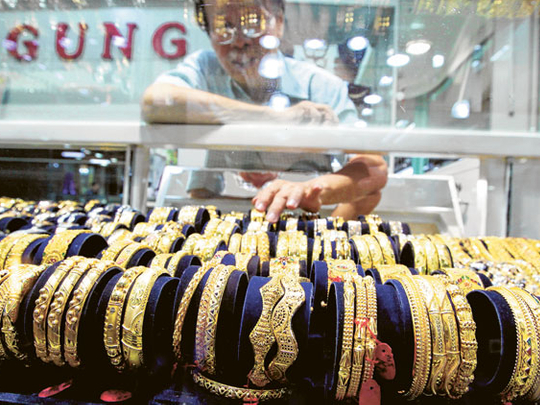
It is unlikely that even two per cent of Indians or Chinese would know who George Soros is or what he does.
But a majority of the 2.5 billion people living in the two countries would feel indebted to him if they realise that the great gold-buying opportunity that came their way of late may be due to what Soros and the likes of him have done with their paper gold investments.
As fund managers like Soros were cutting their holdings of gold-related investments on fear that gold’s safe haven status was under threat, gold consumers in India and China were crowding gold and jewellery shops in a frenzy that saw stocks run out faster than they could replenish. Dubai, renowned for its role as the best place in the world to buy gold, has had an impromptu gold festival under way.
With the price of gold falling below the so-called resistance level of $1,400 (Dh5,140) per ounce on April 16, which incidentally marked a 16 per cent drop this year alone, up to 15 tonnes of the metal were bought over a period of three days in India. Similarly, retail sales tripled across China on April 15 and 16, with Hong Kong and Macau reporting 25 per cent higher turnout in jewellery shops.
The extraordinary demand for the physical gold has baffled a section of the trading community, which was all geared for a bearish grip on the market.
Irrespective of the methodologies employed by paper gold investors to estimate the worth of their holdings and determine the future outlook for the metal, Asians, particularly Indians, do not calculate the value of their gold assets on the basis of the daily changing prices.
For them, gold’s store value also has an emotional component to it, bordering on obsession, and it is a symbol of wellbeing and security. Any price increase adds to the feel-good factor, but any fall in price is not a reason for despair, rather an opportunity to buy more.
In fact, India’s gold imports this year are expected to increase 36 per cent by June this year and according to World Gold Council’s estimates, the world’s biggest gold market is set to see consumption increase to 960 tonnes this year, compared to 864.2 tonnes in 2012. This is despite the fact that the Indian government has tripled the tax on imports since the start of 2012 to moderate demand as gold imports account for almost 80 per cent of the country’s current account deficit.
The government is now wondering whether the steep hike in import duty is really producing the desired results, as a proportionate or even bigger increase in gold smuggling has been reported since the new restrictions have been put in place.
Given both the material and cultural store value of the metal, Indians have never taken kindly to legislative and administrative efforts to restrict ownership of gold.
More than a half a century has passed since Morarji Desai, a former finance minister of India, who later became prime minister, introduced a series of gold control laws beginning 1962, which required all bank loans given against gold as collateral to be recalled forthwith and curtailed the citizens’ right to hold bullion as bars and coins.
Under the law, all bullion had to be converted into jewellery and value declared before the authorities and restrictions were imposed on the quantity of gold that could be held by dealers. He had also floated a gold bond plan, which envisaged all Indians households to hand over their unaccounted gold assets to the government and receive tax benefits in return. Generations of Indian women have not forgiven Morarji Desai for his outlandish schemes.
The gold trade is divided over which way the metal will move, given the increasing threat to its safe haven status. Central banks and fund managers can have their own reasons and arguments to support their respective approaches.
However, as long as Asians consider gold as a symbol of well-being, which was proven beyond doubt during the Asian financial crisis, the yellow metal will continue to inspire value and admiration, like we are witnessing now.
The writer is a journalist based in the UAE.












